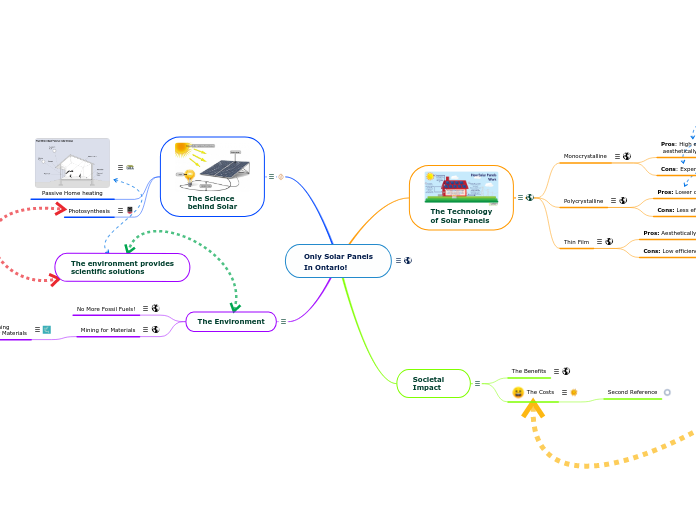Price Feasibility
The environment provides
scientific solutions
Only Solar Panels
In Ontario!
Ontario is in the unique position in renewable energy as it uses more solar electricity than any other province in Canada (Rabson, 2017). In this mindmap, I will argue how the full transition to solar electricity is the best choice for Ontario.
The Environment
Often when people talk about the environment and solar panels, they discuss only the benefits. However, it is important to be nuanced and look at some of the possible negative impacts converting to solar energy would be for Ontarians.
Mining for Materials
Some environmental issues are the chemical waste products during the creation process and the extraction of raw materials from the earth (Kuby Renewable Energy Ltd., No date).
Mining
For Materials
Interesting to note though is that according to Clean Energy Canada (No date) we would not need to mine most of these materials abroad as 14 of the 19 materials necessary are available here in Canada.
No More Fossil Fuels!
The greatest benefit of solar panels is that they produce roughly 4% of the amount of greenhouse gases as coal (Kuby Renewable Energy Ltd., No date). When considering the urgency of climate change this would greatly benefit Ontarians, as well as all humans.
The Science
behind Solar
The sun emits rays of sunlight that enter earth's atmosphere. These rays of light are particles called photons that contain energy. Solar panels collect this energy and transform it into electricity (Marsh, 2019). As seen in the sub-topics solar energy is not just for solar panels. We also use the sun to grow plants and heating.
Photosynthesis
Researchers are trying to find ways to use the process of photosynthesis to generate electricity as plants are very efficient in absorbing sunlight (Hataway, 2013).
Passive Home heating
Another kind of technology of solar energy is passive solar design as seen in the diagram here (Williams College, Date Unknown).
Societal Impact
Transitioning completely to solar energy would cause a massive impact on the society of Ontario, especially the economy. However, what might be surprising is that it isn't totally negative.
The Costs
If everyone switched to Solar panels then a rough estimate of the cost for an Ontarian homeowner would be between 20,000$ -
40,000$ for a 4.5kWh system - 10kWh system, respectively (Wilson, 2013).
Currently, the average cost of electricity in Ontario is 125$ per month for 1Kwh (energyhub, 2020). Therefore, for the same amount of electricity that 20,000$ solar panel can produce the current Ontarian is paying:
(125$/kWh * 4.5kWh) = 562.50$
This is roughly 19,500$ cheaper! Keep in mind this would is an average and would be even more expensive for many Ontarians!
Second Reference
The Benefits
Solar energy creates more jobs per unit of electricity than any other renewable energy source (Katz, Date Unknown). This would create an enormous amount of jobs.
The Technology
of Solar Panels
While not the only technology to harness solar energy, solar panels are the most associated technology. Solar panels are necessary to process solar energy from the sun to transferable AC electricity to be used for an electric grid. There are three major kinds of solar panels.
Thin Film
Mostly used for large scale operations because they are easy to install which makes up for their low efficiency (Sendy, 2020).
Cons: Low efficiency & short life expectancy
Pros: Aesthetically pleasing & easy to install
Polycrystalline
More commonly used by people building solar panels on a budget and the panels have a blue color to them, which some would say is an eyesore (Sendy, 2020).
Cons: Less efficient & not as aesthetic
Pros: Lower cost
Monocrystalline
Monocrystalline are the most common for solar installation for residential areas (Sendy, 2020).
Cons: Expensive
Pros: High efficiency &
aesthetically pleasing









